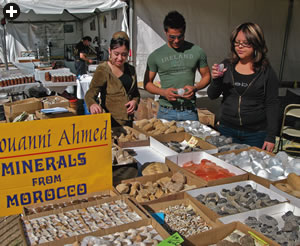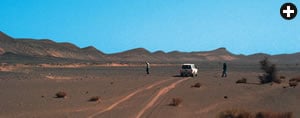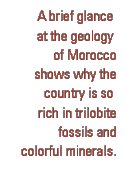 |
 |
 |
| Trilobites, like the ones fossilized here, emerged more than 500 million years ago in what’s called “the Cambrian explosion,” a period when large numbers of novel species with skeletons, eyes and limbs evolved with remarkable suddenness. Trilobites are so called because of the three parts, or lobes, of their bodies. |
| |
|
 |
| At the Tucson Gem and Mineral Show, high school students Vianca Somoza, Eliezer Montes de Oca and Rebeca Montane examine Moroccan fossils and minerals for sale. |
 rowing slowly at first, fossil and mineral exports expanded so rapidly beginning in the late 1980’s and early 1990’s that today more than 50,000 Moroccans earn their livelihoods in the fossil and mineral specimen mining and export business. Collecting, especially among youngsters, has gone worldwide, and the us market is the largest.
rowing slowly at first, fossil and mineral exports expanded so rapidly beginning in the late 1980’s and early 1990’s that today more than 50,000 Moroccans earn their livelihoods in the fossil and mineral specimen mining and export business. Collecting, especially among youngsters, has gone worldwide, and the us market is the largest.
Fossil exporter Brahim Tahiri of Alnif has built an enterprise that supports scores of families in the rural Tafilalt region of southeastern Morocco—where, he notes, “there are no other jobs.” Tahiri got his start in the fossil business when he was still a student, working for his older brother Ali. After Ali died in a car crash in 1999, Brahim stepped up to fill his shoes. Today, the business he runs with his brothers Mohammed and Yousif provides work for about 65 fossil-diggers throughout the Tafilalt region, with an additional two dozen workers employed in the family’s fossil-preparation “factory” near Erfoud, about 115 kilometers (70 mi) northeast of Alnif. Fossils “prepped” by Tahiri’s employees are sold throughout Europe, the United States, Australia and Japan.
 |
| The squid-like nautiloid Orthoceras (“straight horn”) is a classic of Moroccan fossil-hunters, often found in vast numbers in black limestone. The largest specimen here is 60 centimeters (2') long. |
Fossil- and mineral-diggers have made Morocco famous for its trilobites and its Orthoceras-rich limestones. Polished slabs of black limestone streaked with cone-like Orthoceras fossils are sold as curios or fashioned into coffee tables, ornamental sinks and even bathtubs. Finely prepared Moroccan trilobites can be found in the collections of museums great and small, as well as in the homes of innumerable amateur paleontologists. And the country’s colorful minerals, such as bright-red vanadinite and silvery skutterudite, are also the pride of many a great collection worldwide.
Mining normally evokes visions of men digging deep underground for gold, huge trucks hauling iron ore or limestone boulders being crushed to manufacture cement. Tonnage is valued in ordinary mining; delicate crystals and pristine fossils are not.
Moroccan specimen-mining is a delicate, labor-intensive enterprise: The goal is to find and produce attractive samples that can be sold as scientific curiosities, or perhaps even as works of art—so the miner strives to harvest his treasures from the ground undamaged. Dynamite is seldom used. For the teams of men who work in the small pits and trenches that mark the fossil fields, shovels, picks and chisels, and perhaps a backhoe, are the tools of choice. It’s hard, dusty work. Many miners are Berber tribesmen whose families have deep roots in the region.

Once specimens are cut from the earth, local men clean and prepare them for sale. In Erfoud, middlemen gather every Thursday and Sunday to buy the output of the numerous diggers and “preppers.” Around a hundred different export outfits batch the bulk of Moroccan fossil and mineral specimens; these are purchased by dealers at the world’s major fossil and mineral shows, such as those in Tucson, Arizona and Munich, Germany. Then they are sold in lots of dozens or hundreds to gift shops in museums and malls.
It is impossible to estimate how many young fossil collectors have been inspired to take up careers in science by their collections of Moroccan trilobites. What is certain is that specimen-mining is big business in Morocco. In 2000, The New York Times Magazine reported that the fossil trade alone was worth $40 million annually in Morocco, although—as in most similar industries—middlemen and retailers see much more profit than diggers and preppers. American geologist Douglas Shakel has aptly described Morocco’s booming specimen-mining industry as the “trilobite economy.”
Most Moroccan specimen exporters are often away from home. Tahiri, for instance, spends one month a year at European exhibitions and two months in the us, principally in Tucson. There, in late January and early February each year, some 50 different exhibitions take place in hotels and tents throughout the city.
Family heritage plays a big role in the export business, says Ahmed Bouabidi, a fossil and mineral exporter from Midelt, about 200 kilometers (125 mi) north of Erfoud. Bouabidi’s father, a retired miner, worked in the Mibladen lead mine near Midelt and fostered his son’s early interest in minerals. The younger Bouabidi earned a geology degree at Moulay Ismail University in Meknes and got into the specimen-export business in 1992, working with his cousin. Bouabidi’s expertise as a geologist enables him to answer customers’ questions about the fossils and minerals he sells at shows in Tucson; Turin, Italy; Sainte-Marie-aux-Mines, France; and Munich and Hamburg. “Mineral and fossil sales are great for Morocco’s economy,” he says.
For Laheen Boutahar of Beni Mellal, on the edge of the High Atlas Mountains southwest of Midelt, mineral-specimen exports are a welcome addition to his family’s regular mining business: Golden State Mining Company, or gsmc. He and his brothers Ahmed, Mohammed, Aziz and Hassan operate five mines in the High Atlas Mountains and the Middle Atlas to the north. They produce lead, copper and zinc ores, aragonite (used in cement manufacture), selenite (also called gypsum and used to make plaster) and fluorite (used as a flux in the steel industry). While working at the mines, diggers also harvest and prep a variety of mineral specimens for sale to collectors. All told, the family’s mining- and specimen-exporting operations employ about 60 workers.

GSMC has two California offices and markets an array of mineral specimens in America. The list includes bright-green malachite and deep-blue azurite, silvery cubes of galena, and crystals of calcite, selenite, aragonite and fluorite.
Of course, European, American and Asian importers also benefit from Morocco’s trilobite economy. Many have developed a personal fascination with the country’s fossils and minerals while meeting the demand for specimens at home, and have come to cherish the Moroccan people and the country itself.
Most have Moroccan partners; some have Moroccan spouses. Bill Barker, who owns the Sahara Sea Collection in Tucson, works with Brahim Tahiri of Alnif. Brian Eberhardie, a major importer of Moroccan fossils and owner of Moussa Direct in Cambridge, England, is married to a Moroccan named Mina.
Eberhardie does more than import fossils. When an unusual trilobite specimen comes to his attention, he contacts a paleontologist such as Professor Richard Fortey of the Natural History Museum in London. One of Eberhardie’s discoveries, a trilobite with highly unusual, tower-like eyes, is named after him: Erbenochile erbeni. Fortey says that Morocco is home to “three or four hundred” trilobite species. The Natural History Museum has about a hundred specimens, but hopes to acquire more.
A few scientists worry that specimen-mining “exploits” Morocco’s paleontological heritage. Others note that paleontologists have identified hundreds of species of trilobites—many new to science—from finds by miners working the country’s Paleozoic limestones, which were laid down 245 to 570 million years ago. Without markets to support Moroccan diggers, a large number of these species would never have been discovered.
 |
| Kyle Skipper and Natia Copeland shop at the Tucson Gem and Mineral Show for a specimen of Drotops, a 416-million-year-old Moroccan trilobite genus. Most trilobites are 2.5 to 10 centimeters (1–4") in length, but they can range from one millimeter to 70 centimeters (.04–28"). |
Some Moroccan exporters have also made significant contributions to science. In addition to exporting fossils, Brahim Tahiri operates the only private fossil museum in Morocco. The Tahiri Brothers’ Museum of Fossils and Minerals near Erfoud preserves and displays scientifically important specimens to promote geological education. Brahim Tahiri’s efforts have been recognized internationally as paleontologists do: They have named a trilobite, Asteropyge tahiri, in his honor. (He also has the honor of having a non-trilobite fossil arthropod, Eoduslia brahimtahiri, named after him.)
Erfoud lies in the heart of Morocco’s fossil beds, and the Paleozoic strata south of the highway between Erfoud and Alnif are a prime hunting ground for diggers. Kilometer after kilometer of shallow trenches have been hand-dug by Berber miners following productive horizons in their search for trilobites. Diggers crack open rocks and, when they break into a trilobite fossil, save both halves. Broken trilobites are taken to prep labs like Brahim Tahiri’s facility in Erfoud, where they are glued back together. Preppers then painstakingly chip out the trilobites. Their preferred tool is a micro-sandblaster.
Few trilobites are found in perfect condition and prepping usually involves some degree of restoration. Trilobite replicas can be made from plaster, plastic or auto-body putty, and it can be hard for amateurs to tell real fossils from replicas.
The price that a trilobite fossil will fetch in the marketplace depends upon its rarity and condition, the hours spent preparing it and the quality of the workmanship. In the us, trilobites may retail for anything from one or two dollars to several thousand, and some unusual high-quality pieces have sold for more than $20,000. A similar range of prices applies to mineral specimens.
 |
| D.W. Shakel |
| Beyond the tire tracks is one of Morocco’s many trilobite mines, which are typically hand-dug trenches, two to three meters deep. This one continues along the mountainside for 50 kilometers (30 mi). |
Morocco’s mineralogical endowment is as unique as its paleontological heritage. Mines in the world-famous Bou Azzer district, in the center of the Anti-Atlas Mountains south of Ouarzazate, produce cobalt and nickel arsenate ores and colorful mineral specimens favored by collectors. The district lies in a patch of Precambrian rocks that geologists call a boutonnière (“buttonhole” in French). Rocks here are very old and have a very complicated geological history. Immense heat and pressure resulted in the deposition of ore and mineral veins.
Before the onset of modern mining in the 1930’s, Berber tribesmen in the Bou Azzer region chipped out small amounts of arsenic-containing rocks from the cobalt-nickel veins to sell in the Marrakesh suq as rat poison. French prospectors came across the veins in 1928 and the Bou Azzer Mine opened soon after that. As it played out, prospectors identified other ore veins nearby, which were also mined. The region’s rich geological history produced such stunning mineral specimens as erythrite, a violet-red cobalt-arsenate, and skutterudite, a bright silvery cobalt arsenide. More than 120 different mineral species have been found at Bou Azzer, and the district even has an arsenic mineral named after it: bouazzerite.
Who benefits most from Morocco’s mineral-specimen mining and its trilobite economy? Thousands of Moroccans earn a living in the industry. But the results of their work bedazzle and educate collectors, especially schoolchildren, around the globe. “Children know only about cartoon dinosaurs,” says Houcein Mribiha, who hails from Khenifra on the edge of Morocco’s Middle Atlas mountain range and enjoys selling fossils in America. “But, if their parents buy Moroccan fossils, they can learn about geology firsthand.”


 oroccan geology spans a vast period of time. Rock types range from Precambrian granites, gneisses and marbles, formed more than 570 million years ago, through the Paleozoic limestones, to Quaternary volcanics formed within the past million years. In the north, Mediterranean Morocco has a geology that is part of the vast European Alpine system, while the central and southern portions of the country have uniquely complicated “African” geologies.
oroccan geology spans a vast period of time. Rock types range from Precambrian granites, gneisses and marbles, formed more than 570 million years ago, through the Paleozoic limestones, to Quaternary volcanics formed within the past million years. In the north, Mediterranean Morocco has a geology that is part of the vast European Alpine system, while the central and southern portions of the country have uniquely complicated “African” geologies.
Much of Morocco’s Anti-Atlas Mountains in the far south are built of Paleozoic rocks, dating back 245 to 570 million years, and Cambrian, Ordovician, Silurian and Devonian limestones abound. When these rocks were deposited, a warm, shallow sea teeming with life covered the region. Trilobites scuttled along the seafloor, and huge schools of Orthoceras, squid-like nautiloids with cone-shaped shells, swam above. When these creatures died, their shells were preserved in the limy mud of the seafloor.
| |
 |
| |
Morocco is also famous for mineral specimens including, clockwise from top left, cerussite, embedded in iron-stained barite crystals; blue-green fluorite encrusted with white calcite; phosgenite (the large transparent crystal), in a matrix of galena; skutterudite, a cobalt arsenide, named for the town in Norway where it was discovered; and vanadinite, an important ore of vanadium. |
Morocco’s complex geological history makes its rocks host to a variety of economically important minerals. Morocco is the world’s leading exporter of phosphate rock, used to produce phosphoric acid and fertilizers, and—mainly thanks to phosphate mining—the country’s mineral industries are the largest foreign-exchange–earning sector of the economy.
Mining also yields a wide range of other valuable mineral products, including antimony, barite, coal, cobalt, copper, feldspar, fluorspar, iron ore, lead, manganese, salt, silver and zinc. Gold is mined at Lourim in southern Morocco.
Collectible mineral specimens are a by-product of the mining industry. Long after a mine has closed, marketable specimens can be recovered from the spoil heaps and old workings. For instance, world-class specimens of bright-red vanadinite, a vanadium mineral for which Morocco is famous, still come from the Mibladen lead mine, near Midelt in the Atlas Mountains. To the delight of collectors, other old mines continue to produce specimens of aragonite, amethyst, malachite, azurite and a host of other minerals.
 |
Dr. Andrew A. Sicree (sicree@verizon.net) is a professional mineralogist who has served as director of a mineral-science museum. He carries out research for mining companies, teaches university geology classes, designs science-education programs for middle and high schools, and writes about science. He lives in Pennsylvania but—four generations back—his family is from Morocco. |